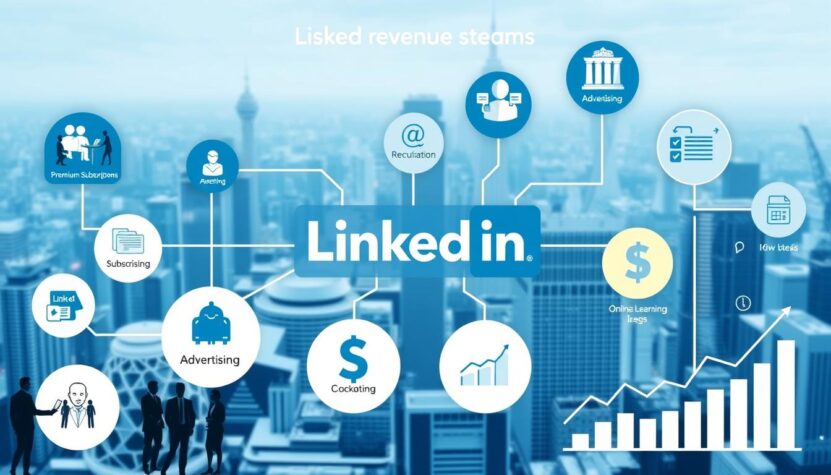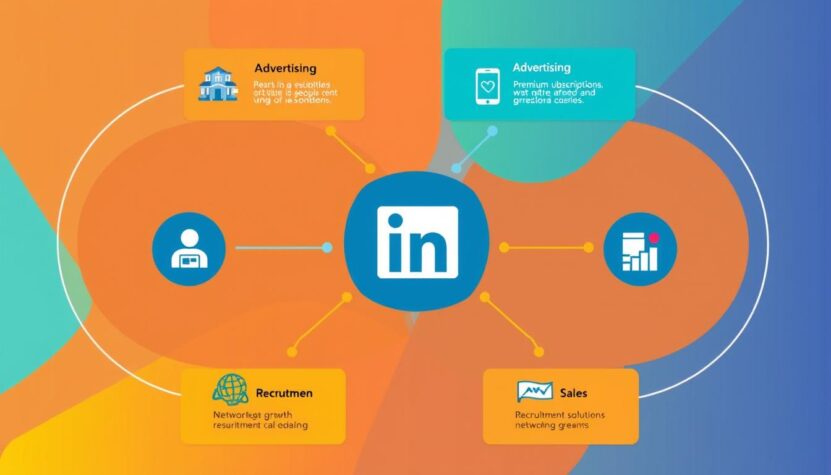Understanding how LinkedIn makes money provides insight into its business model and revenue streams. Since its launch on May 5, 2003, LinkedIn has grown to encompass a professional network of over 900 million members across more than 200 countries. This social media platform has distinguished itself by focusing on professional networking, career development, and offering a suite of services tailored to individuals and businesses alike.
With LinkedIn’s diverse array of offerings, you might wonder how does LinkedIn make money. The platform has successfully leveraged both free and premium services to create multiple revenue channels that cater to its vast user base. In the fiscal year 2021, LinkedIn’s revenue exceeded an impressive $10 billion, reflecting the platform’s notable growth, particularly since it’s acquisition by Microsoft. Key components of the LinkedIn business model include Talent Solutions, Marketing Solutions, Premium Subscriptions, LinkedIn Learning, and Sales Solutions. Each of these segments plays a vital role in generating significant earnings while enhancing user engagement.
Understanding LinkedIn’s Business Model
LinkedIn’s business model is intricately designed to connect professionals while providing them with tools to enhance their networking and hiring potential. With a remarkable user base of over 660 million members and 9 million businesses, leveraging this extensive network becomes paramount. The core elements of the LinkedIn business model include the vast array of user data that can be utilized for targeted advertising and recruitment, which significantly enhances LinkedIn’s appeal to business clients across various sectors.
Core Components of LinkedIn’s Business Model
At the heart of LinkedIn’s financial success lies its diversified range of income sources. Currently, around 65% of LinkedIn’s business model is attributed to talent solutions. These services allow organizations to recruit suitable candidates effectively, while companies either pay subscription fees or adopt a pay-per-use model for accessing these tools. Additionally, marketing solutions contribute approximately 18% to LinkedIn’s overall strategy, with advertisers paying for clicks and impressions to reach potential customers.
LinkedIn also offers a suite of premium subscriptions, including plans like Career, Business Plus, Sales Navigator, and Recruiter Lite, which cater to different segments of users looking for enhanced features. A strategic acquisition of LinkedIn Learning has strengthened its value proposition, providing both professional development opportunities and generating revenue from subscriptions. All these components work together to position LinkedIn as a leading platform for professional hiring and business networking.
The Role of User Engagement in Revenue Generation
User engagement plays a vital role in facilitating LinkedIn’s income streams. The platform emphasizes creating high-quality user-generated content, promoting interactions among professionals, and establishing itself as an authoritative network. This strategy amplifies user retention and attracts more businesses seeking data insights and analytics for their advertising efforts. It’s notable that LinkedIn’s marketing services, surpassing $1 billion in quarterly revenue, demonstrate a 97% year-over-year growth due to effective user engagement strategies.
Through its tailored offerings and commitment to user engagement, LinkedIn continues to achieve remarkable revenue growth, including a record $10 billion in revenue during fiscal year 2021. The platform’s innovative approach to connecting professionals with resources, opportunities, and significant insights is what solidifies its status as a top player in the professional networking space.
How Does LinkedIn Make Money
Understanding how LinkedIn makes money involves exploring three key revenue streams: Talent Solutions, Marketing Solutions, and Premium Subscriptions. Each of these facets contributes significantly to LinkedIn’s overall revenue, allowing the platform to maintain its status as the largest professional network worldwide with over one billion users.
Revenue from Talent Solutions
Talent Solutions stand as a cornerstone of LinkedIn’s revenue model. This segment provides businesses with powerful tools for recruiting and job postings. In 2023, Talent Solutions generated around $7 billion, showcasing its pivotal role in how LinkedIn makes money. Companies leverage this offering to gain access to a vast pool of potential candidates, making it an essential resource for those looking to streamline their hiring processes.
Income from Marketing Solutions
LinkedIn marketing strategies have proven effective in driving user engagement and revenue. The Marketing Solutions segment sells targeted advertising and sponsored content opportunities, enabling businesses to reach specific audiences. In 2023, this segment contributed significantly to LinkedIn’s total revenue, reflecting the growing demand for digital advertising within professional contexts. With approximately 67 million companies maintaining profiles on the platform, the potential for targeted outreach is immense.
Overview of Premium Subscriptions
Premium Subscriptions are an essential aspect of LinkedIn’s offerings, catering to professionals seeking to enhance their networking capabilities. This segment brought in substantial revenue, around $1.46 billion, by providing users with advanced features like enhanced messaging options and deep insights into their connections and interactions. This tiered subscription model serves those who wish to maximize their LinkedIn experience while supporting the broader framework of LinkedIn revenue streams.

LinkedIn Learning and Sales Solutions
LinkedIn Learning significantly enhances user engagement by offering a robust platform filled with various online courses. The subscription model attracts users keen on personal and professional development, increasing their time spent on the platform. With over 106 million active monthly users, the impact of LinkedIn Learning on attracting and retaining subscribers cannot be overstated. This growth leads to additional advertising revenue, making it a vital component for social media monetization.

Impact of LinkedIn Learning on User Engagement
Engagement through LinkedIn Learning fosters a culture of continuous learning. Users gain access to an extensive library of courses covering various topics, which not only enriches their skills but also deepens their connection to the platform. As users interact with this content, they are more likely to engage with other features, leading to increased visibility for advertisers seeking to reach a highly skilled audience.
Sales Solutions for Professionals
LinkedIn Sales Solutions deliver essential tools for sales professionals aiming to maximize their efficiency. Features such as Sales Navigator, enhanced search capabilities, lead recommendations, and InMail messaging streamline lead generation and customer relationship management. With these tools, professionals can analyze sales performance effectively and connect with potential clients directly, driving business growth effectively. LinkedIn sales solutions continue to be crucial for professionals aiming to harness LinkedIn’s vast database for their sales strategies.
Conclusion
In summary, LinkedIn has successfully carved out a prominent position in the professional networking landscape, achieving significant LinkedIn business profits through its versatile revenue streams. With over 660 million users and 9 million companies, the platform leverages user data and engagement to drive financial success. A substantial 65% of its revenue arises from Talent Solutions, which encompass essential services like LinkedIn Recruiter and various job-related advertising options.
As part of its diverse offerings, LinkedIn also provides a suite of Premium subscriptions—such as Career and Sales Navigator—that deliver tailored features for professional development and business growth. This strategy not only enhances user experience but also solidifies LinkedIn’s financial success by attracting premium users willing to invest in their careers. Furthermore, the acquisition of LinkedIn Learning and SlideShare has expanded its reach, fostering a culture of continuous learning.
Looking ahead, LinkedIn’s commitment to evolving its platform and exploring new markets will ensure continued growth in its revenue streams. By maintaining a focus on creating valuable connections, professionals and businesses alike can expect to benefit further from how LinkedIn makes money in an increasingly digital world.
Related Posts:
- Home Insurance Hacks - Save Money Without Losing Protection
- Is AI Helping Us or Hurting Us? A Deep Dive into Its…
- TooTurntTony Net Worth 2025: How Much Does He Really Make?
- Revenue Growth Hacks for Small Businesses ─ Quick…
- Exploring Niagara Falls After Dark ─ The Best…
- Why Does My Car Shake When I Drive Fast? Common…









